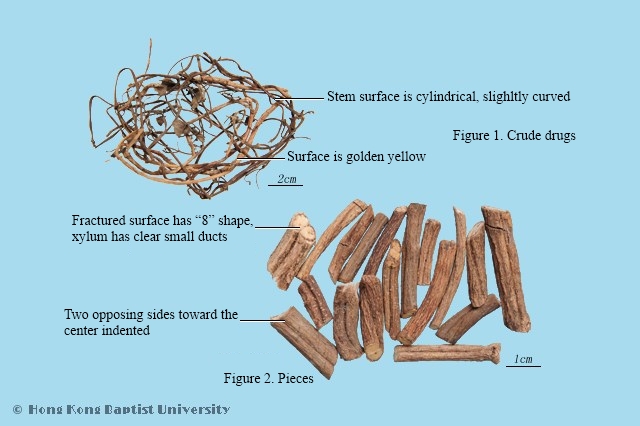Production RegionsPrimarily produced in the Chinese regions surrounding the Yangtze River and to the south of it.
Macroscopic FeaturesStem is flat cylindrical, slightly wrinkled, sparse hairs or nearly no hairs, old stems are grayish-brown, 3~12mm diameter, cortex often falls off, with longitudinal wrinkles and scars of leaf stems, easily broken, fractured surface is flat, grayish-yellow; fresh stems are black-brown, 1~3mm diameter, pliable in texture, not easily broken, fractured surface is fibrous, grayish-white or pale green. Opposing leaves, often wrinkled or crushed, intact leaf is wide oval or lanceolate after being flattened, 5~15cm long, 2~6cm wide, pointy apex, wedge-like base, round or shallow heart-shape, entire, greenish-brown, both sides have no hairs or nearly glabrous; leaf stem is 1.5~7cm long, or with hairs. Cyme grows on the top or axil, top-growing with numerous leaves, axil grows with scattered few flowers, rachis and flower both covered in loose soft hairs, flower is pale purple. Distinctive odor; slightly bitter, astringent taste.
Quality RequirementsSuperior medicinal material has even strips, numerous leaves, potent distinctive odor.
PropertiesSweet, sour; neutral
FunctionsDispels wind, eliminates dampness, digests food stasis, resolves toxin, resolves swelling, invigorates blood, stops pain. Apply to treat rheumatic arthralgia, dyspeptic abdominal distention, retarded growth in infants due to malnutrition, diarrhea, and dysentery, summer heat, jaundice, hepatitis, swelling liver and spleen, cough, scrofula, intestine abscess, swollen toxin, foot dampness and swelling, burnt injury, eczema, dermatitis, injury from falls, bites by snakes and insects.
OriginThe dried stems or aerial portion of Paederia scandens (Lour.) Merr. (Rubiaceae)
